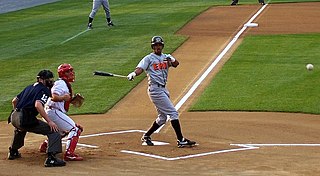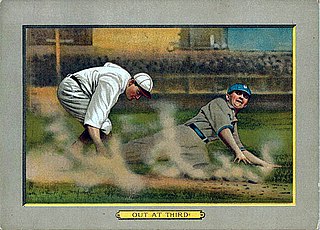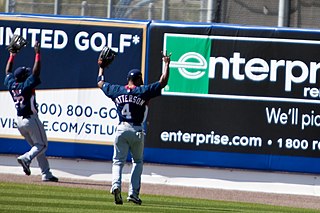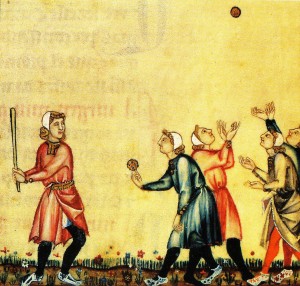
In baseball, a home run is scored when the ball is hit in such a way that the batter is able to circle the bases and reach home safely in one play without any errors being committed by the defensive team in the process. In modern baseball, the feat is typically achieved by hitting the ball over the outfield fence between the foul poles without first touching the ground, resulting in an automatic home run. There is also the "inside-the-park" home run where the batter reaches home safely while the baseball is in play on the field.

Softball is a game similar to baseball played with a larger ball on a field that has base lengths of 60 feet, a pitcher's mound that ranges from 35–43 feet away from home plate, and a home run fence that is 220–300 feet away from home plate, depending on the type of softball being played. It was invented in 1887 in Chicago, Illinois, United States as an indoor game. The game moves at a faster pace than traditional baseball due to the field being smaller and the bases and the fielders being closer to home plate. There is less time for the base runner to get to first while the opponent fields the ball; yet, the fielder has less time to field the ball while the opponent is running down to first base.

A bunt is a batting technique in baseball or fastpitch softball. To bunt, the batter loosely holds the bat in front of home plate and intentionally taps the ball into play. A properly executed bunt will create weak contact with the ball and/or strategically direct it, forcing the infielders to make a difficult defensive play to record an out.

The infield fly rule is a rule of baseball that treats certain fly balls as though caught, before the ball is caught, even if the infielder fails to catch it or drops it on purpose. The umpire's declaration of an infield fly means that the batter is out regardless of whether the ball is caught. The rule exists solely to prevent the defense from executing a double play or triple play by deliberately failing to catch a ball that an infielder could catch with ordinary effort.
Dead ball is a term in many ball sports in which the ball is deemed temporarily not playable, and no movement may be made with it or the players from their respective positions of significance. Depending on the sport, this event may be quite routine, and often occurs between individual plays of the game.

In baseball, a foul ball is a batted ball that:
In baseball, a fair ball is a batted ball that entitles the batter to attempt to reach first base. By contrast, a foul ball is a batted ball that does not entitle the batter to attempt to reach first base. Whether a batted ball is fair or foul is determined by the location of the ball at the appropriate reference point, as follows:

In baseball, an out occurs when the umpire rules a batter or baserunner out for one of the reasons given below. When a player is out, they leave the field and can no longer score. When three outs are recorded in an inning, a team's half of the inning, ends.

The rules of baseball differ slightly from league to league, but in general share the same basic game play.

A baseball field, also called a ball field, sandlot or a baseball diamond, is the field upon which the game of baseball is played. The term can also be used as a metonym for a baseball park.

In baseball, an appeal play occurs when a member of the defensive team calls the attention of an umpire to an infraction which he would otherwise ignore.
In baseball, interference occurs in situations in which a person illegally changes the course of play from what is expected. Interference might be committed by players on the offense, players not currently in the game, catchers, umpires, or spectators. Each type of interference is covered differently by the rules.

In the sports of baseball and softball, a batted ball is a pitch that has been contacted by the batter's bat. Depending on where the ball lands, a batted ball can become either a fair ball or a foul ball. If a batted ball is a fair ball, fielders attempt to get the batter out. A foul ball is assessed as a strike unless the batter has already accumulated two strikes, in which case the number of strikes does not increase. Batted balls are also classified by their trajectory. The most common of these trajectory-based classifications are fly balls, line drives, and ground balls.

A ground rule double is a baseball rule that awards two bases from the time of pitch to all baserunners including the batter-runner, as a result of the ball leaving play after being hit fairly and leaving the field under a condition of the ground rules in effect at the field where the game is being played. An automatic double is the term used to refer to a fairly hit ball leaving the field in circumstances that do not merit a home run. The automatic double is quite often mistakenly called a ground rule double.
The Knickerbocker Rules are a set of baseball rules formalized by William R. Wheaton and William H. Tucker of the Knickerbocker Base Ball Club in 1845. They have previously been considered to be the basis for the rules of the modern game, although this is disputed. The rules are informally known as the "New York style" of baseball, as opposed to other variants such as the "Massachusetts Game" and "Philadelphia town ball".

In baseball, ground rules are special rules particular to each baseball park (grounds) in which the game is played. Unlike the well-defined playing field of most other sports, the playing area of a baseball field extends to an outfield fence in fair territory and the stadium seating in foul territory. The unique design of each ballpark, including fences, dugouts, bullpens, railings, stadium domes, photographer's wells and TV camera booths, requires that rules be defined to handle situations in which these objects may interact or interfere with the ball in play or with the players.

Bat-and-ball games are field games played by two opposing teams, in which the action starts when the defending team throws a ball at a dedicated player of the attacking team, who tries to hit it with a bat and run between various safe areas in the field to score points, while the defending team can use the ball in various ways against the attacking team's players to prevent them from scoring when they are not in safe zones. The best known modern bat-and-ball games are baseball and cricket, with common roots in the 18th-century games played in England.
This is an alphabetical list of selected unofficial and specialized terms, phrases, and other jargon used in baseball, along with their definitions, including illustrative examples for many entries.













